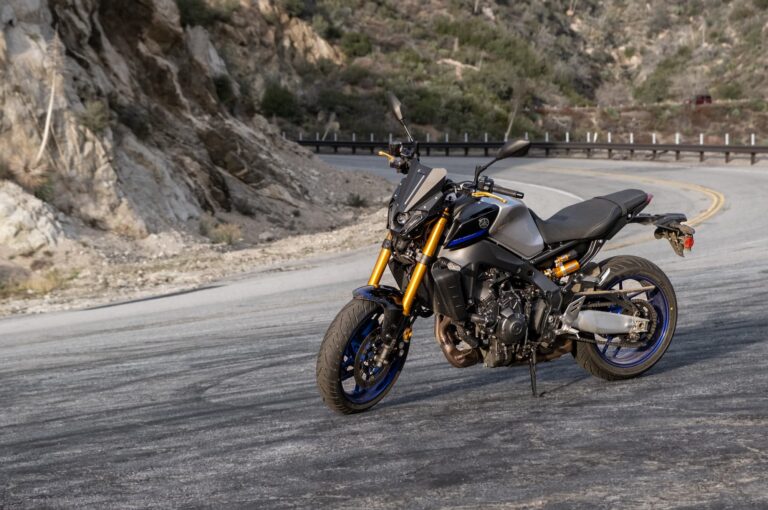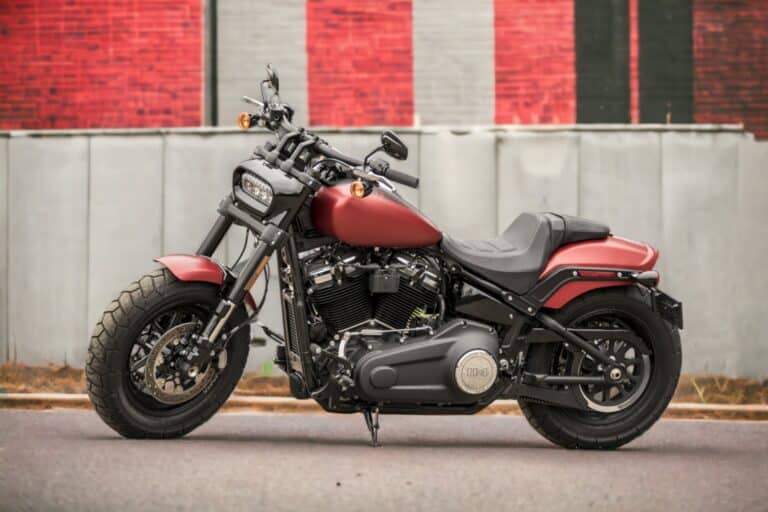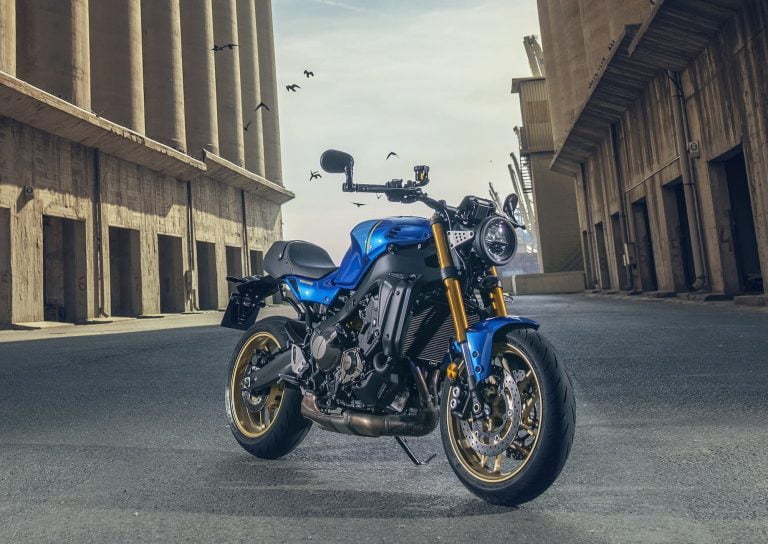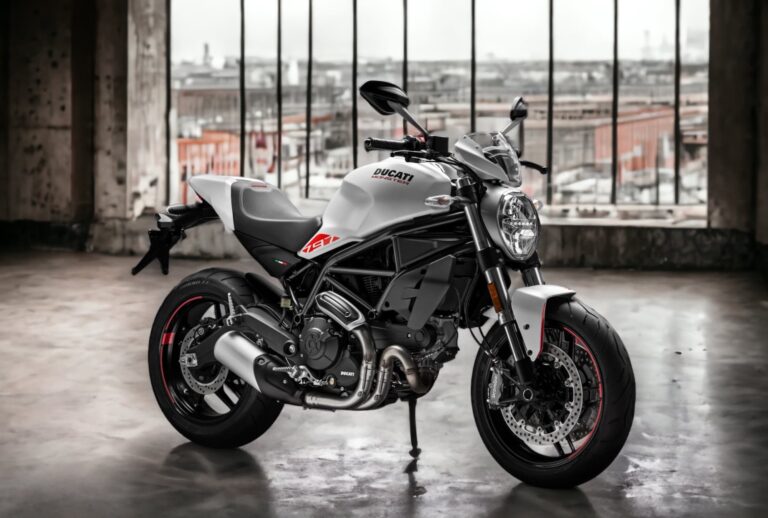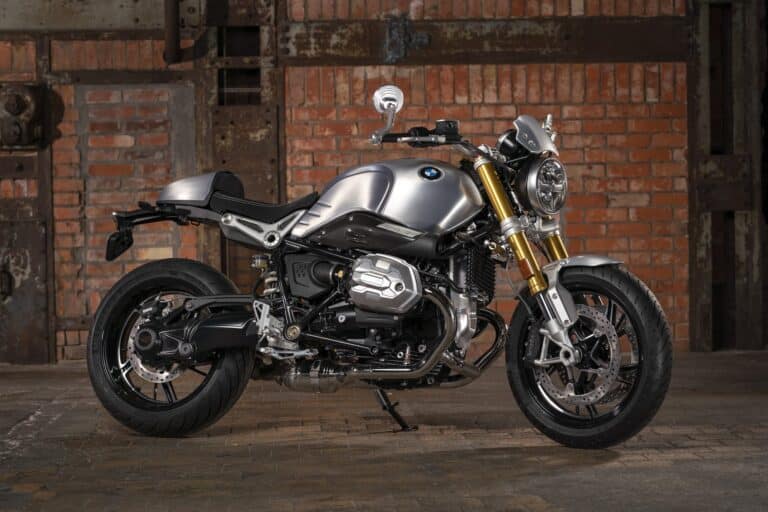The Harley-Davidson V-Rod — especially the Night Rod line — looks like how I feel when I’m riding motorcycles, especially V-twins. That’s it in a nutshell.
But it’s not all roses. Yeah, the V-Rod and the Night Rod (and various other Rods) look stunning, like something Batman would ride. And the engine is a lot of fun most of the time. But the Night Rod’s chassis package is playing catch up, or maybe a different sport altogether.
It’s a conundrum, describing what it’s like riding the Harley-Davidson V-Rod, because the experience peppers moments of pure joy with large swathes of frustration and confidence-sapping unpredictability. I’ll grab the throttle and enjoy the roar, only to be disconcerted by the way the rear tire moves over an undulation in the pavement. I’ll enjoy the forward thrust, only for a ripple in the road to effectively boot me in my exposed bottom, as if I were bending over for a spanking. And I’ll lean into a corner, only to realise to my horror that I’ve leaned too far and have to back off, running wide, directly towards a picturesque country fenceline. Yikes.
In the words of one of my favourite cartoon characters: “She’s built like a steakhouse, but she handles like a bistro.”
But if you don’t push the V-Rod too far… it’s really fun. Like any bike, of course!
Below I’ll go over what I didn’t know about the V-Rod / Night Rod, and what I found out
- A brief intro to the V-Rod for the uninitiated
- What makes them interesting, special, and kind of iconic
- Don’t ride the V-Rod like a sport bike, Dana. But you can still have loads of fun
- Some alternatives to the V-Rod line that are maybe even “better” in some ways
Buckle up!
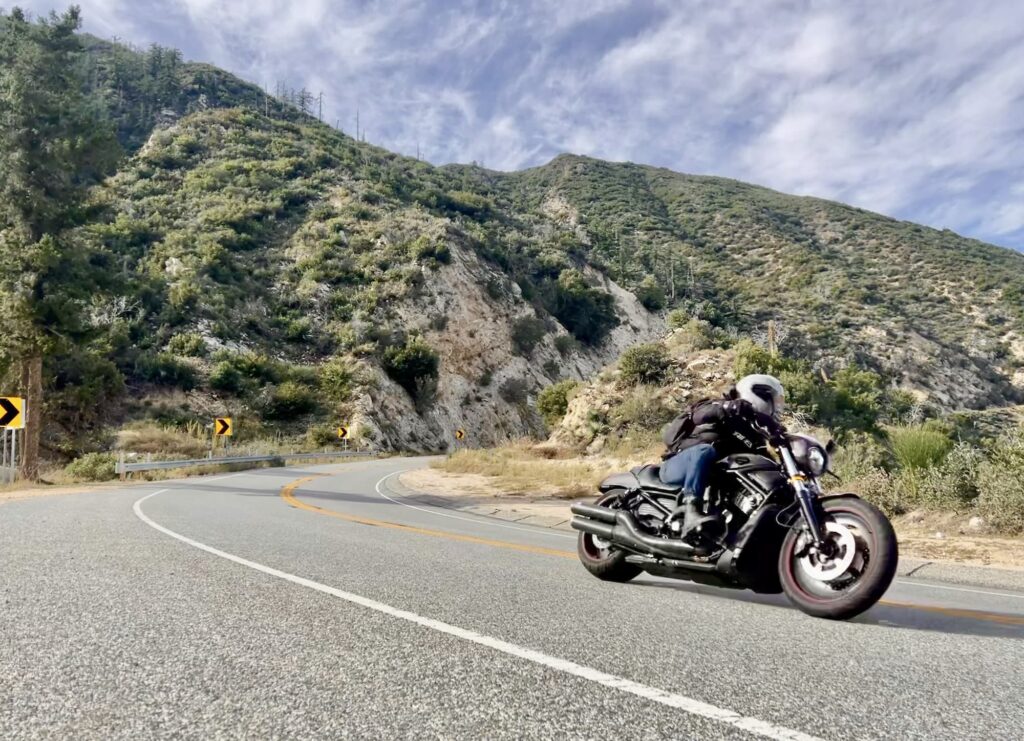
Are you obsessed with motorcycles?
Well, I am. That’s why I created this site — as an outlet. I love learning and sharing what others might find useful. If you like what you read here, and you’re a fraction as obsessed as I am, you might like to know when I’ve published more. (Check the latest for an idea of what you’ll see.)
What is a “Sport Cruiser”, Apart from an Oxymoron?
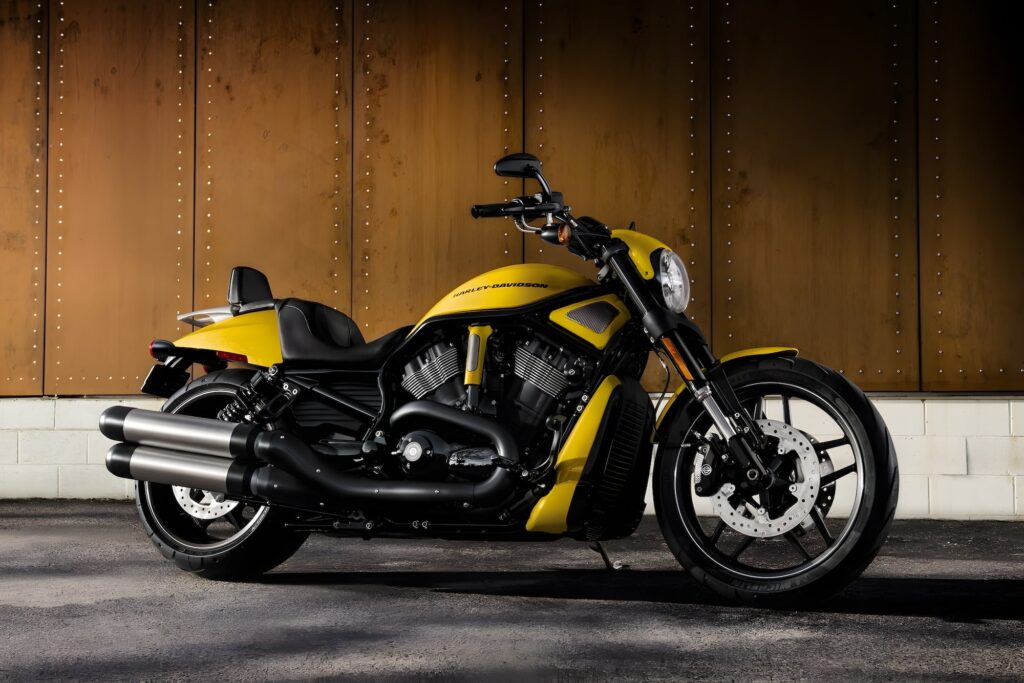
So, why ride a “sport cruiser”? What the **** is that, anyway? Isn’t it a contradiction of terms, like an honest politician, or a reasonable open road speed limit?
It kind of is an oxymoron. A cruiser goes slowly. You cruise. Cruisers were never intended to be quick. Yeah, you can work a Harley and it’ll go much faster, but you can also turbocharge a ‘Busa and it’ll do power wheelies in high gear (I’ve heard).
Cruisers are comfy. Your feet are forwards, like in business class. Sans the fawning attention from stewardesses, it’s nice!
On the other hand, sport bikes go quickly. You hunch forward, like over a racehorse, to keep it from sending you flying backwards when you twist the throttle. The position makes sense for going fast, keeping weight over the front wheel, and your head out of the airflow.
So, on paper, nobody would design a “sport cruiser” for going quickly on a track or even along a drag strip. The only things they do is look and feel cool.
And that they do. Cruisers already feel good. But even big-capacity cruisers can feel anaemic at times. You can grab a bunch of throttle and it does go forward with urgency, but it doesn’t always lunge forward like a wild animal, like a sport bike is more prone to do.
This is where bikes like the V-Rod — and precious few others, including the Yamaha VMAX, Ducati XDiavel, and Triumph Rocket — come in. They’re comfortable, but also have gargantuan engines designed to propel them forwards. Handling is a lower priority; nobody describes those bikes (other than the XDiavel) as great cornering machines. But straight-line, rip-your-arms-off torque is their specialty.
Even though handling is a lower priority, I don’t mean to say that they’re impossible to handle. They just take more thought. I learned that mistake the hard way, which is the best (and most painful) way to learn. Lightweight motorcycles like the Yamaha MT-09 are so light and so perfectly balanced that they’re almost impossible to screw up on — which is why I say they give me a feeling of being in “god mode“. Everything’s in harmony: the torque delivery of the engine, the chassis rigidity, the tires, and the safety net of the ride aids.
Not on motorcycles like the V-Rod. Comparatively speaking, power cruisers are hard to ride. The V-Rod has a heavy clutch, a non-intuitive riding position (for sporty riding), and a fat rear tire. The only easy part is the engine — it delivers torque on demand like a soda fountain delivers sugar. Turn the knob and go berserk.
Sport bikes are designed for sporting, adventure bikes are described for adventuring. Their beauty is in how well they achieve their intended goals. When we (most of us plebs, anyway) lust for a high-end fairing-clad sport bike, it’s largely because we visualise ourselves slaying every corner like our favourite race heroes, even if we only do that occasionally (if ever). Ditto when most of us look at the BMW GS — we imagine ourselves taking it to the furthest corners of the planet, even if 99% of the time, we stay in own corner.
So, again, why a power cruiser? Why the V-Rod? Because of that ineffable thing called “character”. No, I don’t know what “character” is. But I think of “character” as meaning “difficult but rewarding to ride”.
The fact that the V-Rod is loud, ostentatious, and tricky to pilot all are part of that character. Riding it takes concentration, which forces me to be present. This isn’t a bike that just rides itself — it’s the total opposite. So much so that I didn’t think once to put on music in my headphones, and that’s totally aside from enjoying the soundtrack of the engine.
So that’s it, in a nutshell. The V-Rod feels good. Fewer and fewer motorcycles do these days. So when you find something that feels good to you, cherish it, and don’t ask too many questions.
A Brief Intro to the Harley-Davidson V-Rod (and the Night Rod Special)
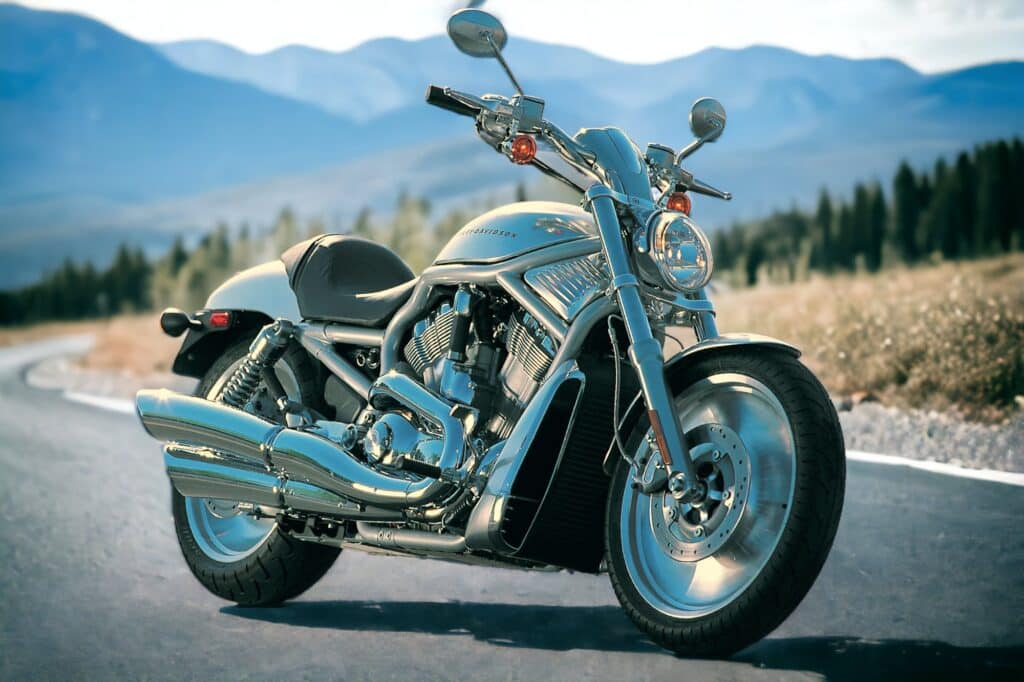
The Harley-Davidson V-Rod was Harley’s sport cruiser — at least until the Sportster S came out. But aside from that, the V-Rod was different things to different people.
To Harley-Davidson, they were an attempt at modernisation, eschewing the shackles of their commitment to air-cooled heritage. They did a lot at once — collaborating with Porsche on design, embracing liquid cooling and high power specs, and even adding on tech like ABS as they became available.
For the Harley-Davidson public, it was too much. While some Harley riders appreciated the V-Rod, it wasn’t a “real” Harley to many. And for the rest of the motorcycling world, it still didn’t make them as appealing as the bikes they already had — sport bikes and adventure bikes, which were all the rage in the 2000s and 2010s in which the V-Rod lived. (There was one brief model, the Street Rod, that regular motorcyclists would like — but it didn’t prove enough to pull most non-Harley fans over to the brand.)
Harley-Davidson launched the first V-Rod in 2001 (in some places for the 2002 model year). At the time, Harley’s had two other main motors — the Evolution motor in the Sportster, and the Twin Cam in the cruisers and tourers. Both those are air-cooled 45-degree V-Twin engines. Both have since been retired — the Twin Cam was phased out finally in 2018 to be replaced by the higher-power but smoother and quieter Milwaukee-Eight, and Harley made its last Evo Sportster in 2020.
At the heart of the V-Rod is a liquid-cooled, torque-rich but also high-revving 60-degree V-twin called the Revolution motor. The redline is quite high — an aspirational 9k rpm. Wow! Peak power comes on at 8250 rpm. And there’s so much torque in the midrange that I rarely even got it near there, shifting in the midrange like one normally would do with sporty V-twins.
By the way, the V-Rod didn’t come out of a void. Harley-Davidson had been collaborating with Porsche Engineering on a racing bike engine already. Harley-Davidson decided to adapt that engine for consumer use, and that’s how the V-Rod was born.
The V-Rod is designed as a performance machine. It’s high-power and can be made to be even higher-power. But that performance is mostly focused on a straight line — most V-Rod bikes have a maximum lean angle of 32 degrees, do not respond well to scraping (ugh), and the fat rear tire is a huge hindrance to anything but forward traction.
It’s not to say that the V-Rod can’t lean. It can. But it doesn’t enjoy it, make it easy, or respond well to being pushed. I’ve ridden other motorcycles with big rear tires, and they weren’t like this!
Over the years of the Harley-Davidson V-Rod, Harley evolved the formula, though not dramatically. They upped the engine size from 1130 to 1250 cc (and the power and torque commensurately). They made the engine blacker, gave it ABS, enlarged the rear tire profile to 240 mm (from 180 mm) and released a few variants with slightly different configurations.
One of the variants that stands out is the VRSCR Street Rod. With an inverted fork, a steeper rake, narrow rear tire, taller suspension, and mid-controls, the Street Rod rides like a regular hooligan sport motorcycle. I really regret that it’s not being made — it is somewhat in the same spirit as the “Bronx” that everyone wishes Harley-Davidson would hurry up and release.
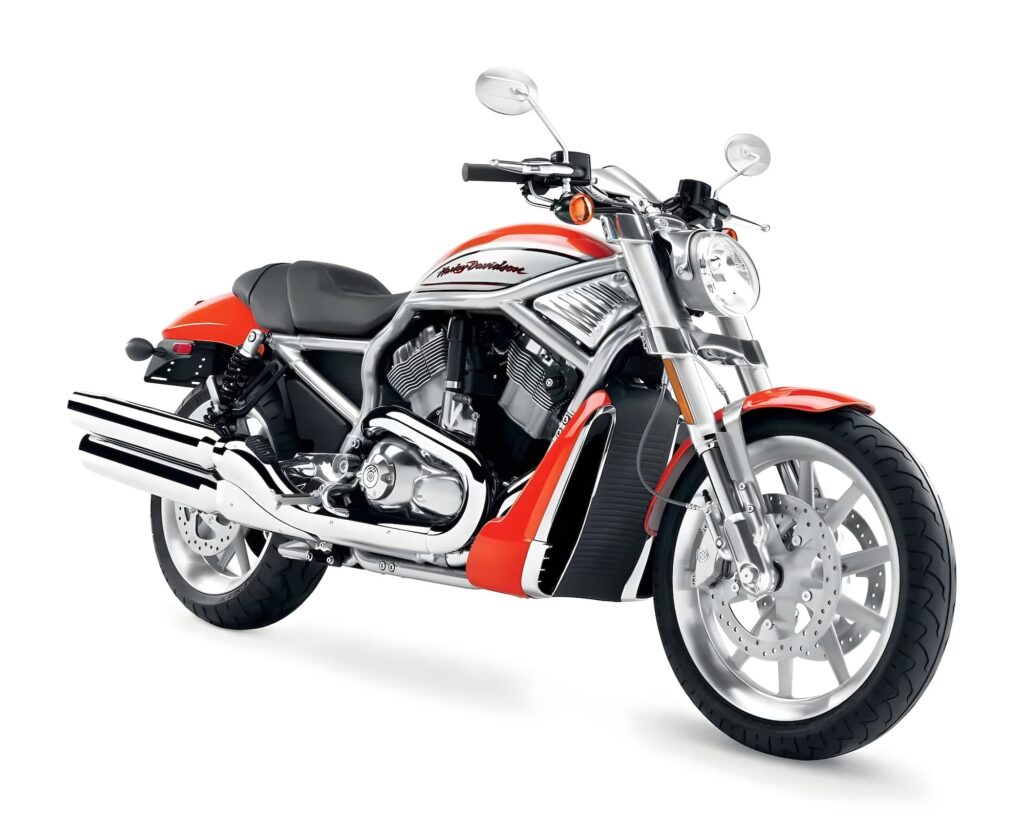
However, I also note that while I (and people like me) enjoy the idea of the VRSCR, it’s still not the one bike I’d lust after. If I wanted a burly V-twin sporty bike, I’d probably get a Ducati Monster. They’re legitimately sporty, loads of fun, and much easier to ride.
And on the other hand, I’ve seen Harley faithful say they wouldn’t ride a VRSCR if it were given to them for free. I feel bad for the designers of the V-Rod line. Just can’t please people, can you!
Anyway, Harley-Davidson released the VRSCDX Night Rod Special variant of the V-Rod line in 2007.
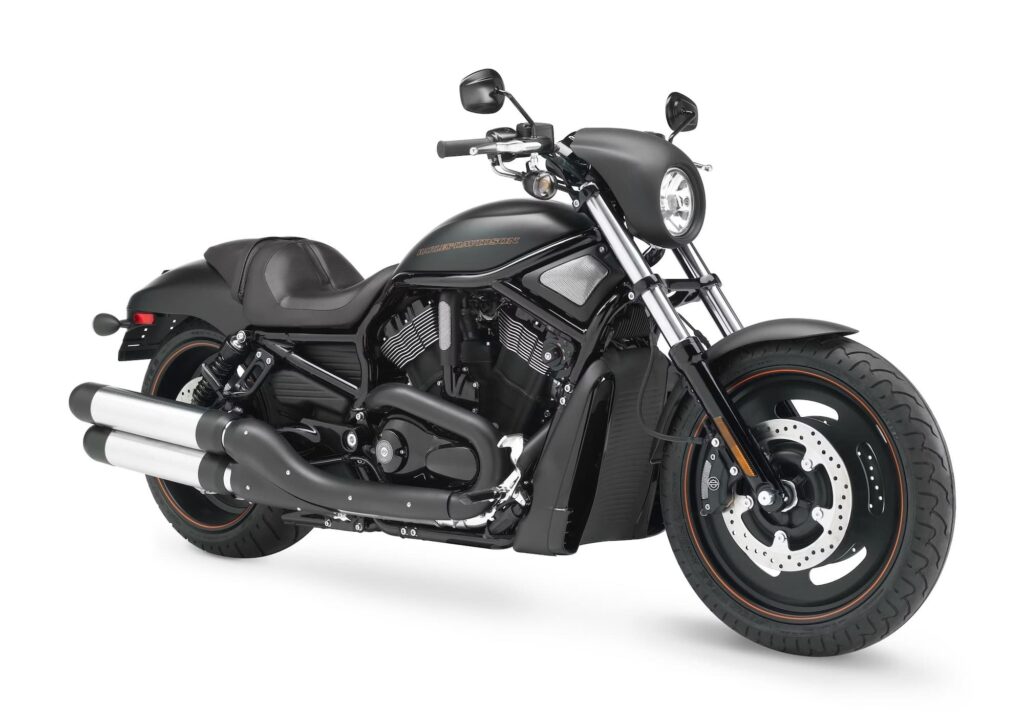
The first year of the Night Rod Special was a bit of an anomaly. It has the 1130 engine, no ABS, but it does have the 240 rear tire. So it’s heavier and a little slower moving due to that tire, but it doesn’t have the bigger engine that would come the next year, until the Night Rod’s retirement. Later models got standard ABS, and also an inverted fork.
I rode the 2007 with the 1130 engine and the 240 rear tire. So my impressions are entirely of that. But I know that my reflections apply broadly to the V-Rod line, from talking to owners and reading their opinions.
See here for the full model history and spec differences of the Harley-Davidson V-Rod motorcycle range.
Specs of the 2007 VRSCDX Night Rod
Here are the specs of the 2007 VRSCDX Night Rod. It’s an anomalous year, as I mentioned above, so this is just relevant for this year.
| Part | Spec |
|---|---|
| Engine | Liquid-cooled 60-degree V-twin, “Revolution”, DOHC, 4 valves/cylinder |
| Engine capacity | 1131 cc (69 ci) |
| Fuelling | Fuel injection |
| Bore / stroke (mm) | 100 x 72 |
| Compression ratio | 11.3:1 |
| Peak power (kW / bhp) @ rpm | 86 kW / 115 hp @ 8250 rpm |
| Peak torque (Nm / ft-lb) @ rpm | 105 Nm / 77 lb-ft @ 6600 rpm |
| Front suspension | 49mm conventional fork, 4-inches (102 mm) travel |
| Rear suspension | Twin shocks, 4 inches (102 mm) travel |
| Front brakes | Twin 300 mm discs, Brembo 4-piston calipers |
| Transmission | Five-speed |
| Final drive | Belt |
| Weight (In running order) | 307 kg / 676 lb |
| Front tyre size | 120/70 ZR-19 |
| Rear tyre size | 240/40 R-18 |
| Ride aids / electronics | None |
Riding the 2007 VRSCDX Night Rod
With a machine that carries with it so many aspects of brand and legacy — Harley-Davidson, V-Rod, and even Night Rod (a name that strikes fear in the hearts of the faithful), I was more than apprehensive before even getting on the Nigh Rod.
I mean, it looked huge. I had ridden feet-forward cruisers before (like the Indian Scout Bobber and the Harley-Davidson Sportster S), but the V-Rod line has a reputation.
Harley-Davidson owners are a little different from most motorcycle owners. I’ve rented a bunch from Riders Share and Twisted Road. Usually, I rent street bikes, and they’ve sometimes been down a few times. The owners seem to be semi-detached from owning them, and accept crashes happen.
Not Harley owners. Harley-Davidson owners tend to know every single little blemish on the bike. They clean, polish, and wax them religiously. They have fond memories of shenanigans conducted on them. There’s more of an emotional attachment. (I’m not saying non-Harley owners don’t form emotional attachments. But I haven’t ever seen someone rent their prized 80s sport bike or whatever on a rental platform.)
But the guy renting the Night Rod to me for a couple of days on Riders Share was relaxed. He said he hadn’t ridden it in years, and that’s why he had been renting it out. He saw I looked concerned, though. “It looks heavy,” he said, “but it lightens up on the road.” I had heard and experienced this before, so I was hopeful. I hadn’t heard that about Harleys, though. So off I went into the Los Angeles traffic, heading for the hills…
Before anything about the bike,, I noticed that the clutch was heavy. I thought my hand would get pretty tired by the end of the day. But I quickly got used to it.
I don’t think Night Rod felt lighter on the road, though. The Night Rod stayed heavy. However, having power to the rear wheel at least let me turn somewhat.
This is riding the Night Rod in a nutshell. It’s a weird, ungaingly bike. But it has such a legacy, and such a cool motor, that I kept making excuses for it. The ten percent of joy would make up for the ninety percent of awkwardness. I suppose it somewhat averaged out…?
Let’s start with the best bit — the engine. It’s glorious!
A lot of people like V-twins, and I’m one of them. I think of myself as having a balanced view, because I also like triples and fours (yes, fours!). And I’ll add that not every twin is one I automatically like. But I do like the one in the V-Rod. It roars, has torque from down low, and somehow it even revs quite high.
The V-Rod I was riding had an aftermarket Screaming Eagle exhaust and boy, was it loud. I’ve had loud exhausts before, but this one made me shove my earplugs all the way into my ears. (If I did it halfway, I’d suffer a weird resonating effect in my ear that was worse than no earplugs at all!)
What really surprised me about the V-Rod’s engine was its willingness to rev. It feels, to me, like a modern air-cooled Harley (from the Milwaukee-Eight era) that keeps going. You get past 5K revs and yeah, you can short shift it, or you can keep going up to highway speeds (well, depending on the highway). There’s a lot of thrust there!
While I was still getting used to the feet-forward position, I at least was happy that the mirrors were in the right place, and so were the controls and instruments. Sport cruisers do this better than naked bikes (as do adventure bikes). You sit more “into” the bike on the V-Rod, so everything is conveniently not far from eye level.
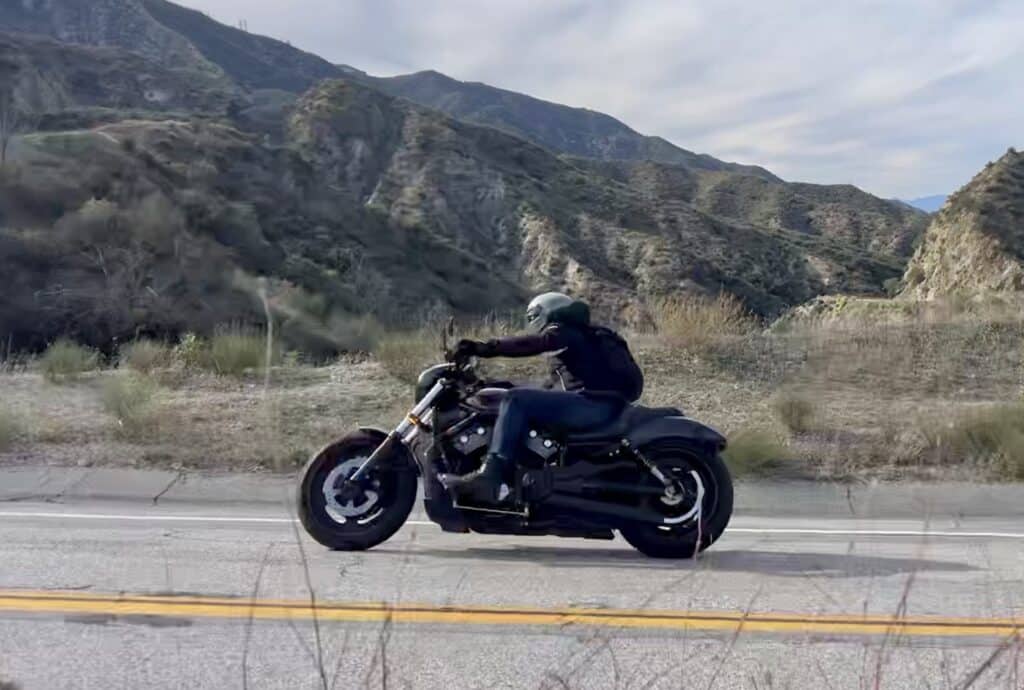
I have to say — through all my time riding the V-Rod, I never quite got used to where my feet went. Quite a few times, I’d set off and my feet would hover in the air, wondering where they were supposed to go.
Once in place, I found to my dismay that I got that awful back pain that I had been hearing about from the “clamshell” riding position. Feet forward, arms forward, lower back curved… it takes its toll. I’m not exactly weak, either; I have spent way too many years in the gym picking things up and putting things down again, being yelled at to improve my form by good coaches, and I’m still very active.
Every human is built differently — different weight up and down, different sized legs, arms, and torso. The Night Rod, in stock form, doesn’t fit me well. I know I’m not alone, too.
Of course, that doesn’t mean you can’t modify it, if you own one. Swept back bars and some slight foot peg rearrangement would make a huge difference. I’m a fan of “standard” controls though — something like the Triumph Bonneville T120 — and I don’t think you can quite get the Night Rod to do that.
Despite all the “weird” things about the V-Rod — or maybe because of them — I really enjoyed riding it, and was sad when the day’s riding came to a premature end (a story for another day).
Every time I grabbed the throttle on the highway, I’d think “Phwaaarr!!” as the motorcycle made approximately the same sound. It was funny; I’ve been faster, on smaller bikes. But the V-Rod did it better.
Even when cornering — not the V-Rod’s happy place — I felt the same way. I knew I wasn’t hanging off, and my boot would occasionally remind me that terra firma was precariously close, but still, I’d feel like I was tearing it up. It was really easy to get that feeling on the V-Rod. I think that’s why it captures the imagination.
The hardest part about riding the V-Rod was that the engine insisted that it was a sport bike, but the rest of the bike kept reminding me that it was not. Occasionally, I’d have to make quick adjustments, and be startled that I didn’t have the latitude that a different riding position and 2/3 the weight would afford me. This was what vexed me the most.
But if you can find that balance for yourself, then I can see why the V-Rod / Night Rod brings joy to so many.
A Quick Word on Maintenance Requirements
Anyone considering the V-Rod needs to consider one important part of the ownership experience — the V-Rod engines have dual overhead cams and don’t have hydraulic self-adjusting valves. This means that they have mandated valve clearance inspections, every 15000 miles / 24000 km (it used to be less, but Harley-Davidson extended it for all engines in a service bulletin).
Even the liquid-cooled dual overhead cam Revolution Max motor in the Sportster S and Pan Am has self-adjusting hydraulic valve tappets (see Harley-Davidson’s tech briefing) which means no valve service adjustments.
Valve jobs are the hardest and most often overlooked part of motorcycle ownership. One of the best parts of Harley ownership is that you don’t have to do them. It’s assumed, as it has been the case for all their major engines. So if you’re thinking of a V-Rod, beware — you’ll occasionally have an un-fun day in the garage, or a service bill of around 4-6 hours (depending on the mechanic’s speed and what else needs to be done).
Some early V-Rods (including the one I rode) have a notoriously unreliable fuel gauge. Sometimes it works, sometimes it does but is inaccurate, and sometimes it doesn’t work at all! The fuel sending unit often fails. Owners usually just go off mileage since the last fill.
Apart from that, you do have to change the oil and adjust the belt. The good news is that over time, the V-Rod hasn’t been known to be catastrophically unreliable.
Alternatives to the Harley-Davidson V-Rod / Night Rod
When I think of motorcycles like the V-Rod / Night Rod — ballsy cruisers with forward controls, aggressive style, and decent power — I think of mostly a few other V-twins, like the Ducati XDiavel, the Indian Scout Bobber, and Harley-Davidson’s own Sportster S.
The thing is, it’s hard to pigeonhole the Night Rod. If I describe its features — the engine, the riding position, the power — it still doesn’t really convey the core of the riding experience, which is basically “sporty bad-ass”. In that spirit, those are the bikes that first come to mind as alternatives.
What’s interesting is that these alternatives only became available at the tail end of the V-Rod’s era, which means they wouldn’t have been alternatives at the time — but they are now, in terms of where you put your money. So no wonder many think that the V-Rod was just ahead of its time!
There are a few others that I’ve intentionally excluded. The Suzuki Boulevard M109R is a glorious fast cruiser, but it has a massive engine that feels different. And the Honda Rebel 1100 has a similar displacement engine, but in true Rebel form, it’s designed to be more of a user-friendly everyday cruiser than a style-forward machine like the V-Rod, so it’s not aimed at the same market. Not to discount them — and if you do find yourself predisposed to those quick summaries, they’re great machines and you should check them out.
Ducati XDiavel
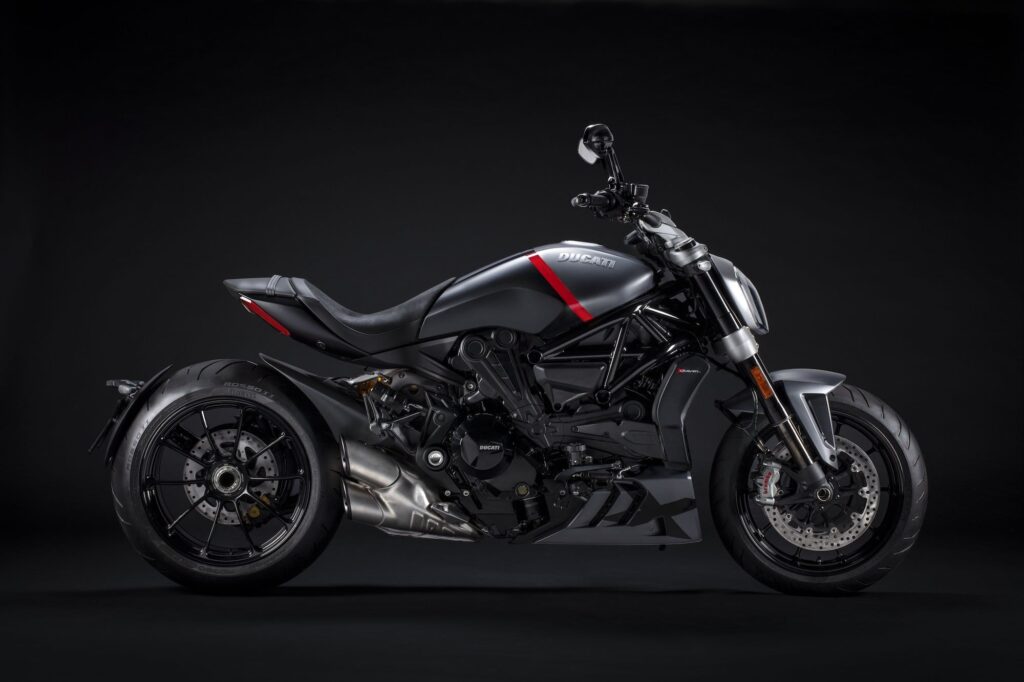
The Ducati XDiavel is Ducati’s feet-forward power cruiser. Ducati released it with the 1262 cc VVT Testastretta-11 engine that makes over 120 kW / 160 hp. Ducati has since updated the Diavel (no X) to the V4 motor, but the XDiavel is still a V twin (at time of writing).
The XDiavel redefines the power cruiser segment because it actually handles well. It has high-spec suspension, good cornering clearance (40 degrees on each side), and low weight for its class (245 kg / 545 lb wet).
See more here in the Ducati Diavel / XDiavel buyer’s guide.
Despite its virtues, the XDiavel is polarising. It’s not going to win over Harley-Davidson fans, but it may appeal to Ducati fans who want a cruiser-style rider for some reason. I see very few of them on the road. But when I do see one parked — usually at a dealer — I can’t help but swoon.
In terms of maintenance, the XDIavel’s Testastretta-11 motor has 18000 mile / 30000 km valve service intervals, and a Desmodromic valvetrain. It also has cam belts that have to be replaced every five years.
Harley-Davidson Sportster S
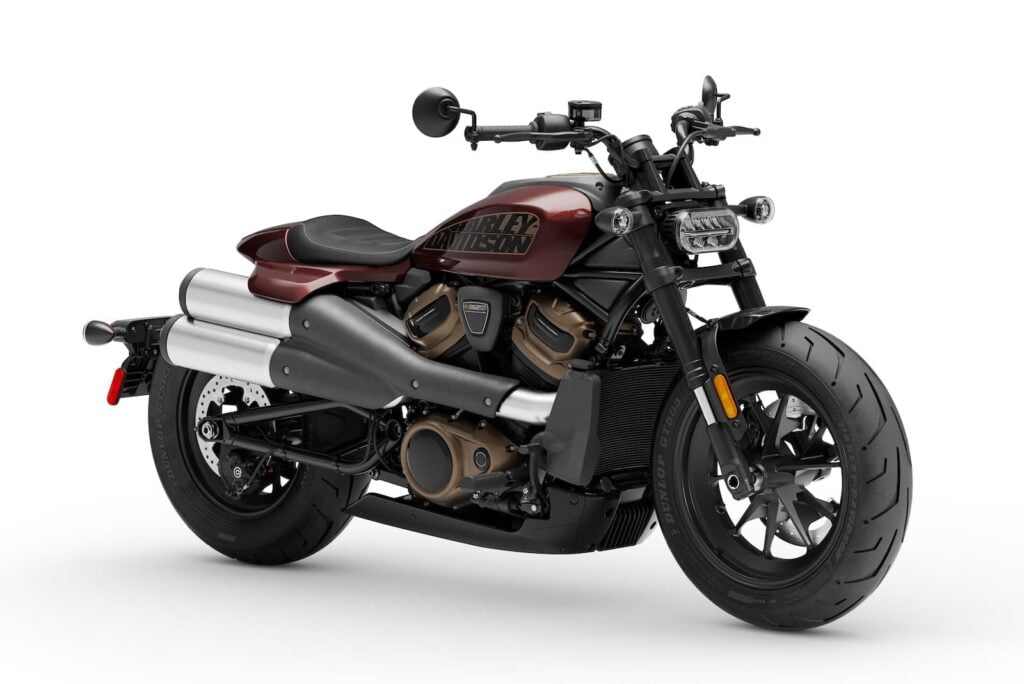
The 2021 Harley-Davidson Sportster S is a really interesting bike from Harley-Davidson. It has a brilliant engine, it’s loaded with tech, it looks great… and, for some reason, it has forward controls and a high-ish seat that make me feel (and look) like I’m on the bike, not in it.
Aesthetically, the Sportster S looks a bit like a Fat Bob. But it doesn’t quite feel like one. For a Harley, the Sportster is light, powerful, and very advanced. This bike’s liquid-cooled “Revolution X” motor makes 90 kW / 121 hp at 7500 rpm, and ride aids include cruise control and even an IMU (Cornering ABS)!
The Sportster S takes over from the “Evo” Sportster line. But it’s entirely different. It’s actually sporty! I just wish there was something like this in a riding position I liked — the fat front tire and the forward controls betray its abilities slightly, and mids don’t solve it. I’d customize one if I had the resources.
See here for my impressions riding the Harley-Davidson Sportster S.
One cool and very underrated thing about the Sportster S is that, like many Harley-Davidsons (but in contrast with the V-Rod), it has no hydraulic valve lash adjusters, which means no valve service requirements.
Indian Scout Bobber
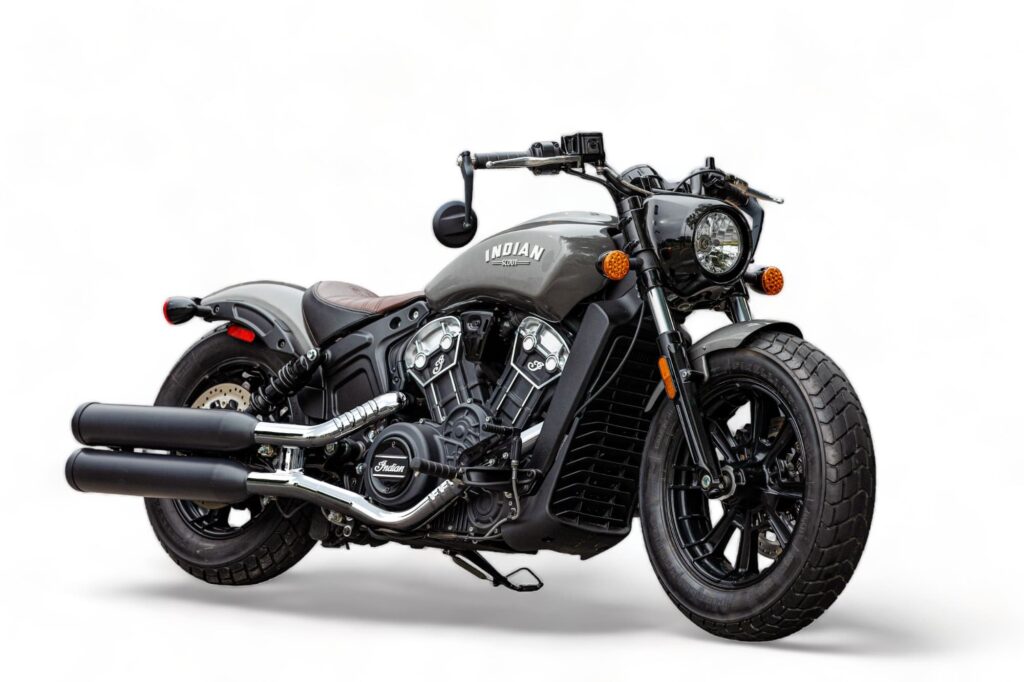
The Indian Scout Bobber is another modestly high-power, modestly lightweight cruiser.
Like the other motorcycles above, the Indian Scout Bobber is powered by a middleweight cruiser-style engine. Its 1133 cc (69 c.i.) liquid-cooled V-twin makes peak power of 100 hp, with its peak torque of 98 Nm / 72 lb-ft coming on at 5900 rpm. With a wet weight of 251 kg / 553 lb, it’s not exactly lightweight — but it definitely is for a cruiser.
Also, while the Indian Scout Bobber does handle well, it scrapes fairly early, with its lean angle of 29 degrees. You can get there without even really trying.
I really like the Indian Scout Bobber. It looks great, and it feels quick at moderate speeds (which are the ones I typically use in everyday life). I’m not a huge fan of forward controls, though, and there’s no variant of the Indian Scout with mids.
Like the V-Rod, the Indian Scout engine does not have hydraulic valve lifters, and so has a required valve service every 20000 miles / 32000 km.
Wrap Up
I’m really glad I was able to rent a V-Rod on Riders Share. I’m not sure I’d have ever gotten it out of my system otherwise without owning one!
I’m trying to broaden my horizons, riding as many kinds of motorcycles I can, finding their secret sauce. In riding the V-Rod, I learned what the hype was about the engine. The hype is real. It’s a great engine!
But I felt let down by the handling experience. I knew intellectually that the weight, position, and tire would add up to a weird ride, but wasn’t sure how much of it would translate into my personal experience. Unfortunately, in this case, it 100% did.
What’ sinteresting to me is that despite that, I can see why people would own a V-Rod or Night Rod anyway. The motor. It’s just that good.
Plus, and this isn’t to be discounted, The V-Rod / Night Rod looks as good as it feels when I’m riding it. That is a super rare thing to be able to say. RIP, Night Rod. You were ahead of your time!


